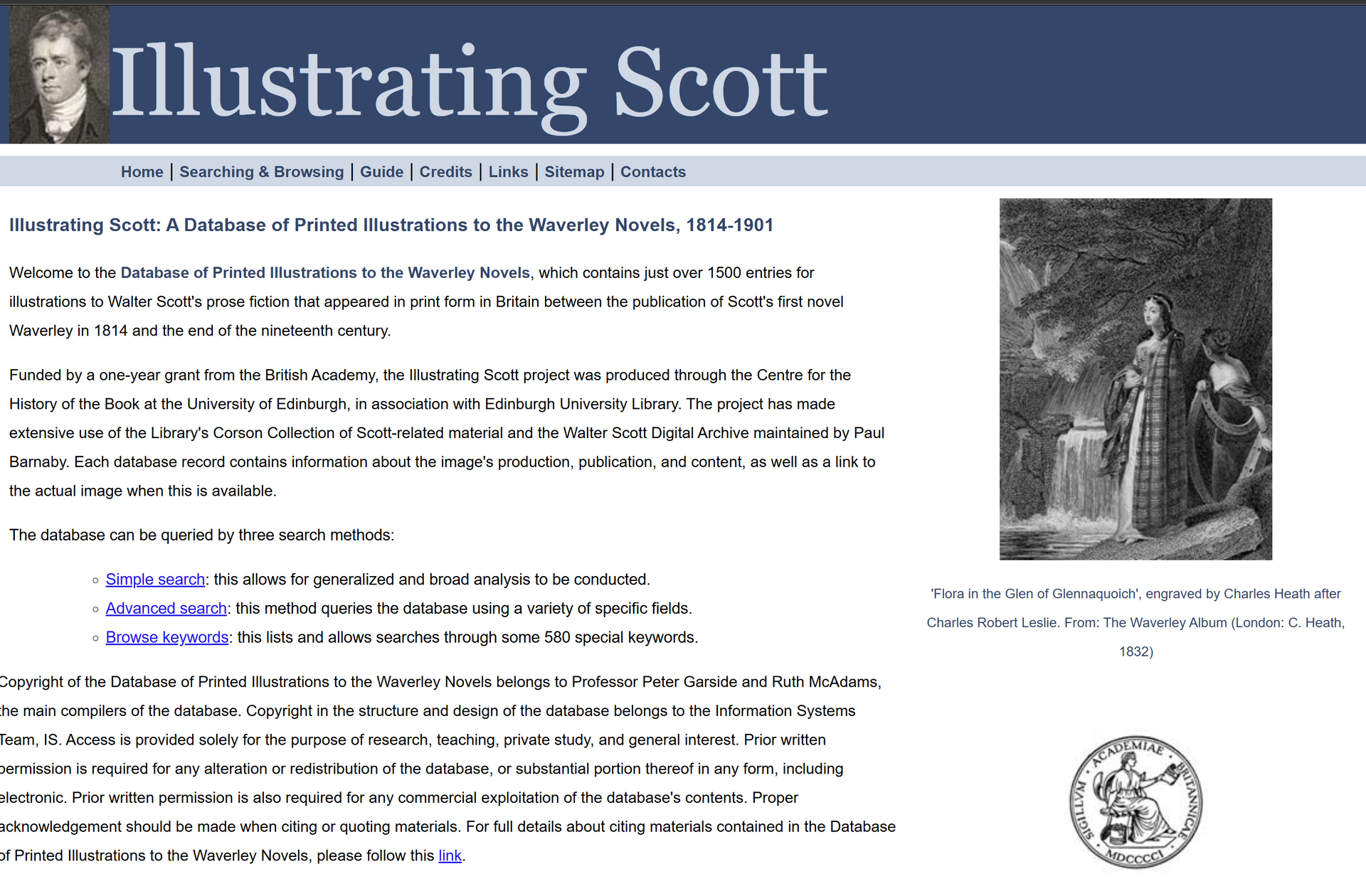Illustrating Scott's Fiction
Professor Peter Garside
Thursday 13th October 2011
Summary of the Talk:
The lecture focuses on the creation and contents of the online database [Illustrating Scott], which compiles over 1500 illustrations related to Sir Walter Scott's novels from the period 1814 to 1901. The resource, launched two years prior to the lecture, includes records of illustrations, with details such as the artist, engraver, and the scene or character depicted.
- Creation of the Database:
- The project was a one-year effort funded by a British Academy Small Research Grant and aided by existing collections at Edinburgh University, including the Corson Collection and [Walter Scott Digital Archive].
- The database contains illustrations primarily from 19th-century editions of Scott's novels, with over 800 entries from works published from 1814 to 1871 and 375 from separate books of illustrations.
- Entries include over 50 engravings from early periodicals, such as The Lady’s Magazine.
- Database Design:
- It categorizes illustrations according to 14 fields, including the name of the work, artists, illustration types (e.g., lithographs or etchings), dimensions, and keywords related to characters, themes, and locations.
- A notable feature is the Subject Keywords field, which categorizes the visual elements, such as animals, people, and events.
- Illustrations' Significance:
- Illustrations in Scott's novels were initially rare for new novels at the time, but became more common, especially after the 1819 publication of Novels and Tales of the Author of Waverley.
- The first illustrations were often retrospective, such as those by Alexander Nasmyth, depicting scenes based on Scott's descriptions.
- By the mid-1820s, both Edinburgh and London became key sites for Scott-related illustrations, with artists like Sir William Allan, Charles Robert Leslie, and Richard Westall contributing.
- Impact of Illustrations:
- Scott’s novels, particularly Ivanhoe, inspired extensive illustration in various formats, including separate illustration suites and those included in full editions like the Magnum Opus (1829-33).
- The illustrations were aimed at enhancing the reader's experience, often adhering closely to Scott's textual descriptions. However, there was also a trend toward dramatic interpretations, such as those by Westall, which sometimes strayed from historical authenticity.
- Later Editions and Continued Influence:
- As editions continued into the mid and late 19th century, including the Abbotsford (1842-47) and Library (1852-53) edition, the importance of illustrations persisted. Publishers like A. & C. Black introduced new designs in the 1870s, often incorporating artwork by Scottish artists.
- The lecture concludes with the impact of Scott’s illustrations in modern editions, particularly by Penguin and World’s Classics, which still use illustrations as a marketing tool to appeal to readers.
Interesting Points:
- Illustrations and Historical Accuracy: The shift from strictly historical to dramatic or picturesque representations is an intriguing aspect of Scott's illustrated editions. This balance between artistic license and historical detail is an important theme for those studying the evolution of book illustrations.
- Scott's Influence on Illustration Trends: Scott’s role in shaping the use of illustrations in fiction is significant. His novels, illustrated by well-known artists, helped set the standard for other literary works, influencing the inclusion of images in the marketing of novels.
- Contemporary Relevance: The ongoing debate regarding the use of illustrations in modern editions, especially the importance of ensuring they match the narrative tone, continues to influence publishing decisions today.
This lecture and the [Illustrating Scott] database highlight the essential role of illustrations in the reception of Scott’s work and their impact on how readers interact with his fiction.
Download the [transcript]

Download the [transcript]


